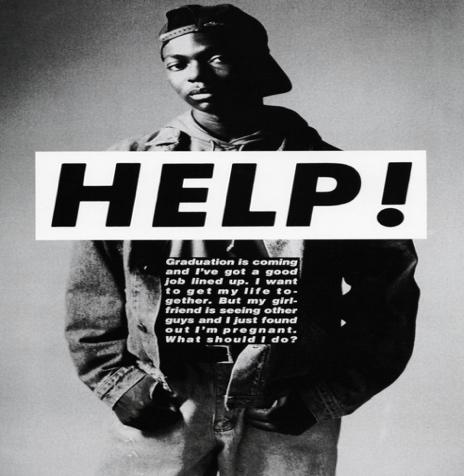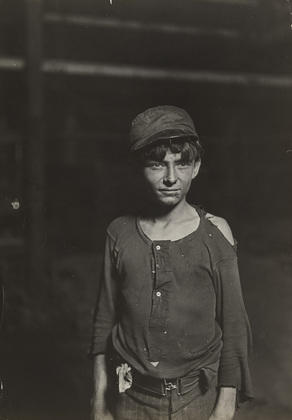It is often argued that contemporary artists completely reject the norms established during the previous cultural periods. Nevertheless, by comparing the works of different painters or photographers, one can say that sometimes, present-day authors can use the techniques and themes which were quite popular in the past. This paper is aimed at discussing Lewis Hine’s photograph called Indianapolis and Barbara Kruger’s installation, which is known as Help! Overall, in both cases, the authors use art as a method of supporting people who are underprivileged or marginalized. Nevertheless, unlike Lewis Hine, Barbara Kruger chooses to combine different media, and in this way, she departs from the canons of the modernist art. These are the main questions that should be discussed more closely. Overall, this comparison can be useful for understanding the relationships between modernism and contemporary art.


One should first discuss the context of these two works. It should be mentioned that Lewis Hines’s photograph was taken in 1902 at the time when many people living in the United States were profoundly affected by poverty. At that time, child labour was a widespread phenomenon. Moreover, at the beginning of the twentieth century, America was passing throw a period of rapid industrialization. In turn, the author focuses on the boy probably works in a factory in order to support his family. Thus, one can say that Lewis Hine’s photograph reflects the social trends that emerged at the beginning of the twentieth century. In turn, Barbara Kruger’s installation was made in 1991. Certainly, since 1902 the United States has undergone a profound change; yet, in the early nineties, the country was still affected by inequality. In particular, one should speak about the problems encountered by African Americans. In turn, Barbara Kruger depicts a teenager whose life can be influenced by such factors as lack of educational opportunities, crime, and unemployment. The early nineties were marked by many racial riots in the United States. To some degree, the author attempts to raise the awareness of the audience about their experiences. It is possible to say that Barbara Kruger and Lewis Hine act as social advocates. These are some of the main points that should be considered.
To some degree, Barbara Kruger and Lewis Hine share a common ideology. In particular, one should mention the premise according to which art should empower those people who are marginalized due to some reasons. This is one of the main similarities that can be identified. Apart from that, in both cases, Barbara Kruger and Lewis Hine rely on photography. Moreover, in both cases, the authors show that photography has the capacity to reflect the feelings of a person. It should not be regarded only as a method of copying reality. Both authors use photography as a tool for depicting the diverse experiences of an individual. Furthermore, their works indicate that a photographer should be able to capture the most appropriate moment in order to give viewers insights into the inner world of a person. This is one of the main peculiarities that can be distinguished because it can throw light on the techniques used by Barbara Kruger and Lewis Hine.
Certainly, there are some distinctions that should not be overlooked. In particular, Lewis Hine does not want to combine photography with other art forms. In contrast, Barbara Kruger incorporates textual messages in her installation. To a great extent, the combination of different media such as visual images and the text is a distinct mark of the contemporary art. Thus, to some degree, Barbara Kruger challenges the artistic canons developed during the previous artistic periods. In particular, her approach to art implies that a person should not be limited by rigid conventions. This eclecticism is critical for modern-day artists who prefer to combine different styles, genres, and media. This approach gives them more opportunities for creative freedom.
Overall, this comparison indicates that the works of Lewis Hine and Barbara Kruger have common attributes. Much attention should be paid to the authors’ attempts to empower those individuals who can be more vulnerable due to some reasons. Nevertheless, one should keep in mind that Barbara Kruger challenges the artistic conventions developed during the modernist era. In particular, this author prefers to combine different media. In contrast, Lewis Hine works only with visual images. The discussion is important for understanding the way in which modernism and contemporary art are related to one another. One cannot say that these movements are completely isolated from one another.
Bibliography
Darden, Joe, and Richard Thomas. Detroit: Race Riots, Racial Conflicts, and Efforts to Bridge the Racial Divide. East Lansing: MSU Press, 2013.
Frazier, John. Race and Place: Equity Issues in Urban America. Westview Press, 2009.
Harris, Jonathan. Art History: The Key Concepts. New York: Routledge, 2006.
Hindman, Hugh. Child Labor: An American History. New York: M.E. Sharpe, 2002.
Hine, Lewis. Indianapolis. 1902. Web.
Kruger, Barbara. Help! Web.
Sealander, Judith. The Failed Century of the Child: Governing America’s Young in the Twentieth Century. Cambridge: Cambridge University Press, 2003.